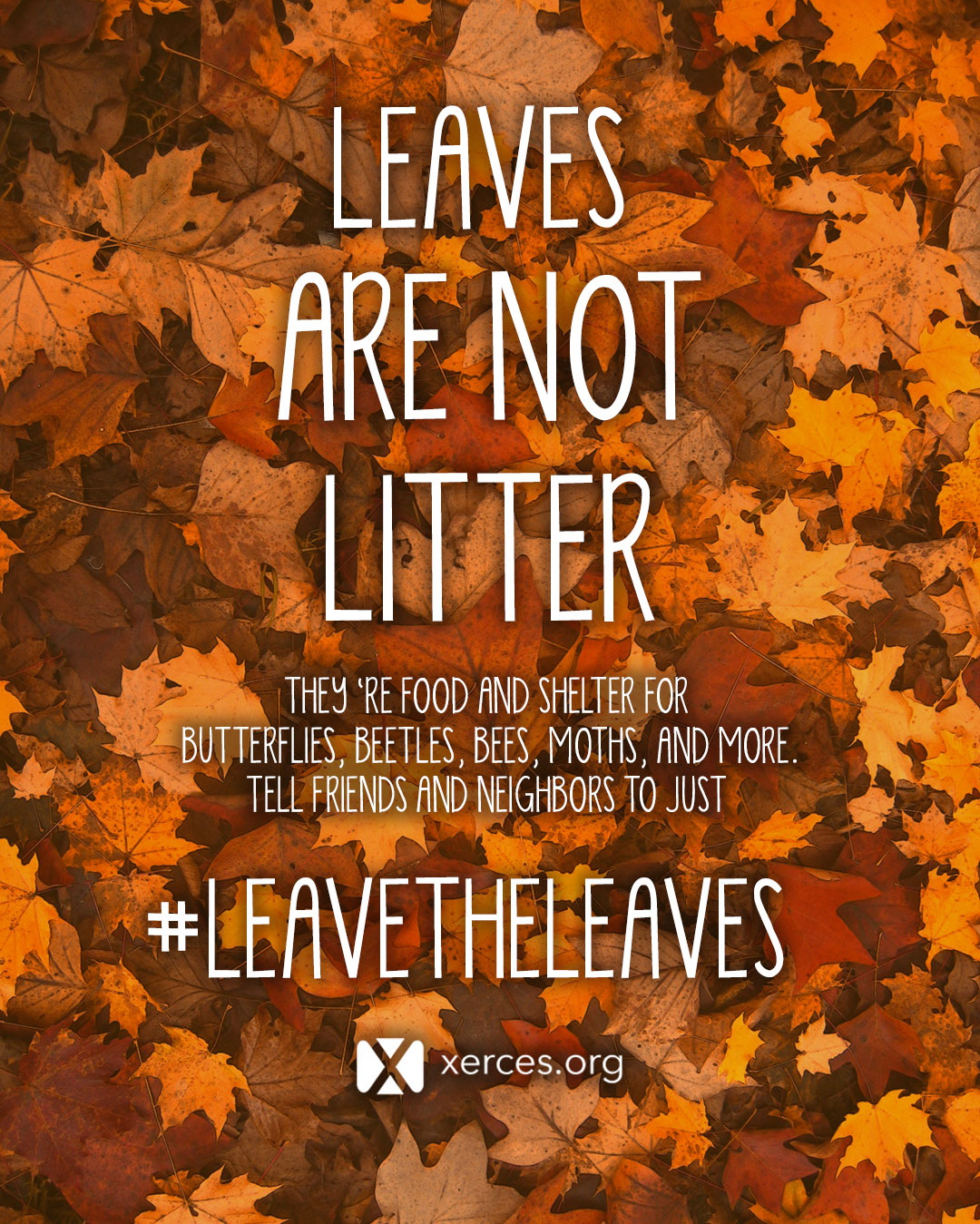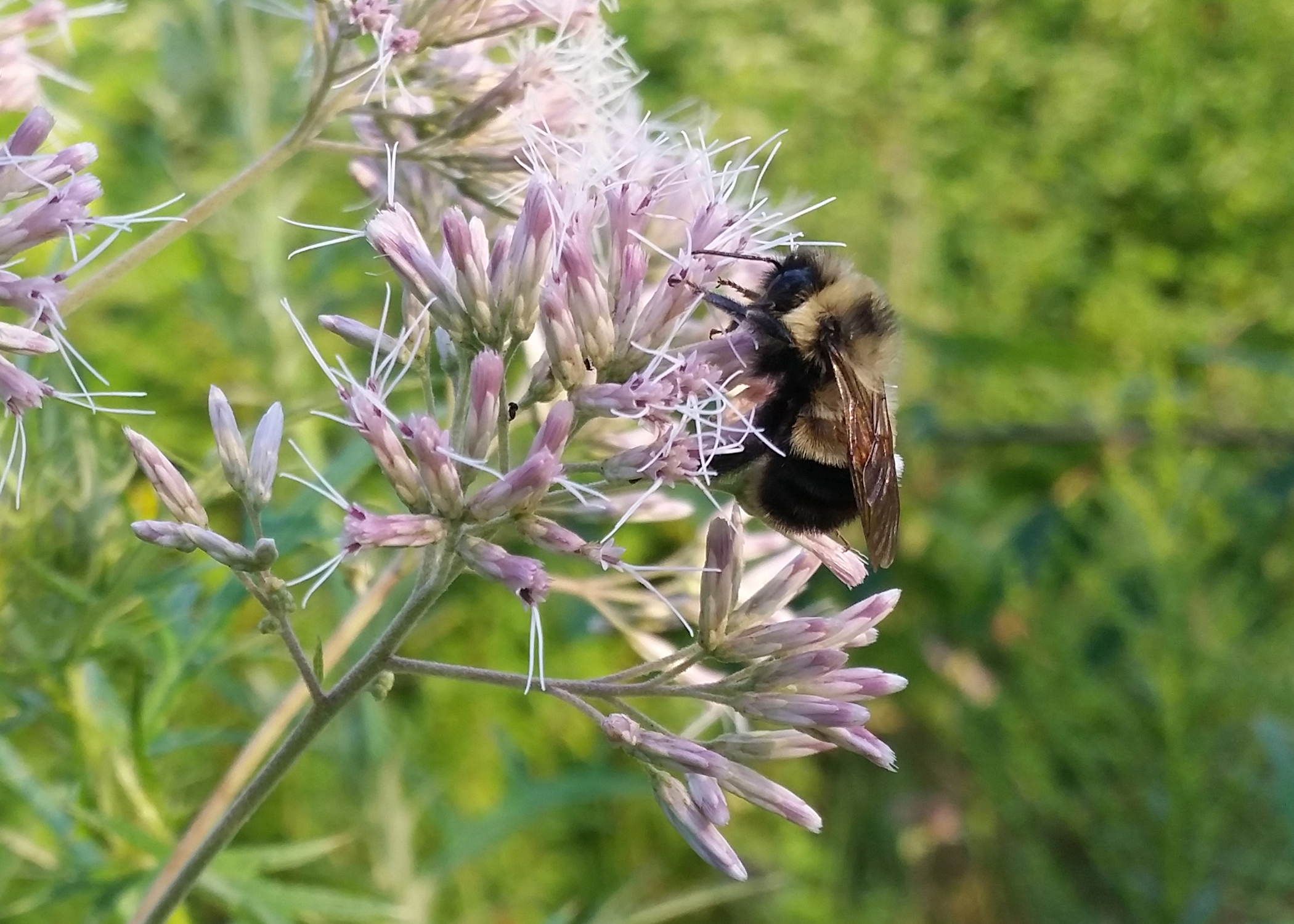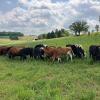Fall is an important time to create habitat for bumble bees and other native pollinators.
The growing season may be winding down, but fall is an important time to create habitat for bumble bees and other native pollinators. The work you do now will help support overwintering pollinators and support the next generation of bumble bees.
Creating Fall Bee Habitat
As a start, consider leaving some “natural chaos” in the spaces you manage, such as newly fallen leaves, branches and logs, and loose dirt. These elements benefit overwintering queens that need insulation (that’s what the leaves are for), and materials to build their overwintering sites (rotting logs and loose dirt).
In this vein, the Xerces Society launched the Leave the Leaves campaign last year, and it is still going strong. The Leave the Leaves campaign encourages homeowners to not only leave their leaves, but also provides ideas on beneficial ways to incorporate them into the landscape. We also recommend creating brush piles and keeping grass tussocks and fallen logs, to help create both overwintering habitat and nest sites. Simple steps like these provide natural habitat for overwintering bumble bees and a host of other beneficial insects. We all will be reaping the rewards in the spring and beyond!

Using Bumble Bee Watch Records to Guide Plant Choice
Depending on your region, fall can be a great time to install new habitat that will support foraging bumble bees next season. Careful planning now can make a big difference when bumble bees need food the most: when they first emerge from hibernation, and food sources are limited. Having floral resources available in early spring is especially important for early-emerging queens as they establish their colony. Putting these plants in the ground now will ensure they are blooming and ready for bumble bees when they wake from their winter slumber.
For guidance on bumble bee habitat needs and their preferred forage plants, in addition to the many printed plant lists available from Xerces and other sources, we’ve searched Bumble Bee Watch for some bumble bee specific recommendations. The observations in Bumble Bee Watch provide evidence based insight into the needs of different bumble bee species and therefore can help us to create habitat that supports common and rare bumble bees alike.
Bumble Bee Watch records also help to shed light on common early season food plants for bumble bees, and provide information on seasonality of foraging resources. For instance, early-season shrubs like rhododendron, azalea, and willow provide floral resources as soon as bumble bees emerge and help early-emerging species to establish a successful nest. In the west, yellow-faced bumble bees (Bombus vosnesenskii) and black-tailed bumble bees (B. melanopygus) rely on resources of this sort, as does the common eastern bumble bee (B. impatiens) in the east. Other early season shrubs and trees that bumble bees are documented as visiting on Bumble Bee Watch include Ceanothus spp. (California lilac or New Jersey tea) and various apple varieties (Malus spp.). Nearly 20 species of bumble bees have been observed visiting these plants, including rare bumble bees like the western bumble bee (B. occidentalis) and the yellow-banded bumble bee (B. terricola).
While early shrubs and small trees are essential for queens starting a nest, the colony will also need food continually through fall. Although considered primarily as host plants for monarch caterpillars, milkweeds (Asclepias spp.) are a great mid-season native perennial that provide abundant nectar for pollinators, including bumble bees. Records from Bumble Bee Watch suggest this plant supports many different species of bumble bees including four rare bumble bees: Crotch’s bumble bee (B. crotchii), western bumble bee, and Morrison’s bumble bee (B. morrisoni) in the West and the rusty patched bumble bee (B. affinis) in the Midwest. In addition to these four at-risk bumble bees, Bumble Bee Watch records on milkweed include 21 species from 29 U.S. states and 6 Canadian provinces. It is important to focus on species of milkweed that are native to your area. In that vein, please note: Tropical milkweed should not be used. Please see Tropical Milkweed: A No-Grow for more information. Planting native species of this celebrated monarch host plant in your landscape will benefit a diversity of pollinators!
Late-flowering species in the aster family such as goldenrod and asters provide forage into September and October. In fact, these are some of the most frequently visited flowers according to Bumble Bee Watch records, with almost 700 records on goldenrod (Solidago spp.) and nearly 450 observations of bumble bees on asters (Symphyotrichum spp.). The records for these two plants come from 24 U.S. states and 9 Canadian provinces, with at least 26 different bumble bee species visiting them, including rare species like the western bumble bee, the yellow-banded bumble bee, and the rusty patched bumble bee.
Once common throughout much of the east, the rusty patched bumble bee has been lost from most of its range, and is now listed as endangered by the U.S. Fish and Wildlife Service. For those who live in its former range, we highly recommend utilizing Bumble Bee Watch’s data to help build habitat in support of this imperiled species. Of 371 verified Bumble Bee Watch records of this at-risk bumble bee, over 50 percent have been recorded visiting beebalm (Monarda spp.), giant hyssop (Agastache spp.), goldenrod (Solidago spp.), and joe-pye weed (Eutrochium spp.). Of course, we can’t promise that these plants will be successful in attracting rusty patched bumble bees to your property, but if they do show up, we know they will appreciate these floral resources. The upshot is that many other pollinators (including monarchs and other bumble bees) will benefit from these flowering plants, too!

With over one-quarter of bumble bee species on the decline in North America, it is increasingly important to find ways to support these important pollinators. Protecting, creating, and restoring habitat in a diversity of landscapes is critically important to conserve remaining populations of bumble bees from the threats they face. To help researchers learn more about bumble bees and to contribute to their conservation, please consider joining Bumble Bee Watch to participate in this continent-wide effort, and to contribute to this invaluable source of information.
If you live in the Pacific Northwest, your observations can also help to put bumble bees on the map in Idaho, Oregon, and Washington—thanks to a coordinated effort by the Washington Department of Fish and Wildlife, the Idaho Department of Fish and Game, the Xerces Society, Oregon State University, and the Oregon Department of Agriculture. The Pacific Northwest Bumble Bee Atlas aims to understand more about bumble bee distribution and the habitat features that are important to them across the region. Please stay posted as we ramp up for another season of the Atlas project in early spring 2019.
Although many of us, wherever we live, will have to wait until spring for the buzz to return to our landscapes, right now we can sow the seeds that will support bumble bees in our gardens next year. We encourage you to do your part to support the life that sustains us.
(Please note: floral species are not verified on Bumble Bee Watch, thus we are dependent on the knowledge of the contributors that listed these plants as the host plant of the visiting bumble bee.)





